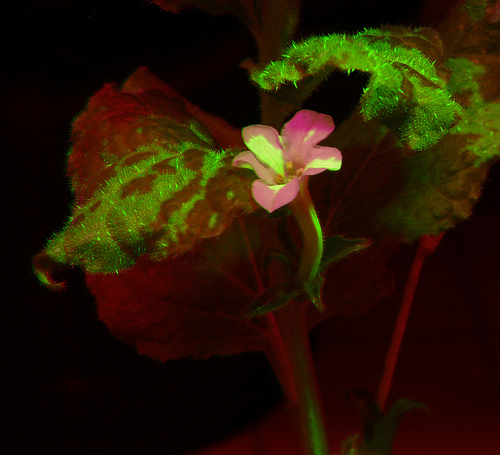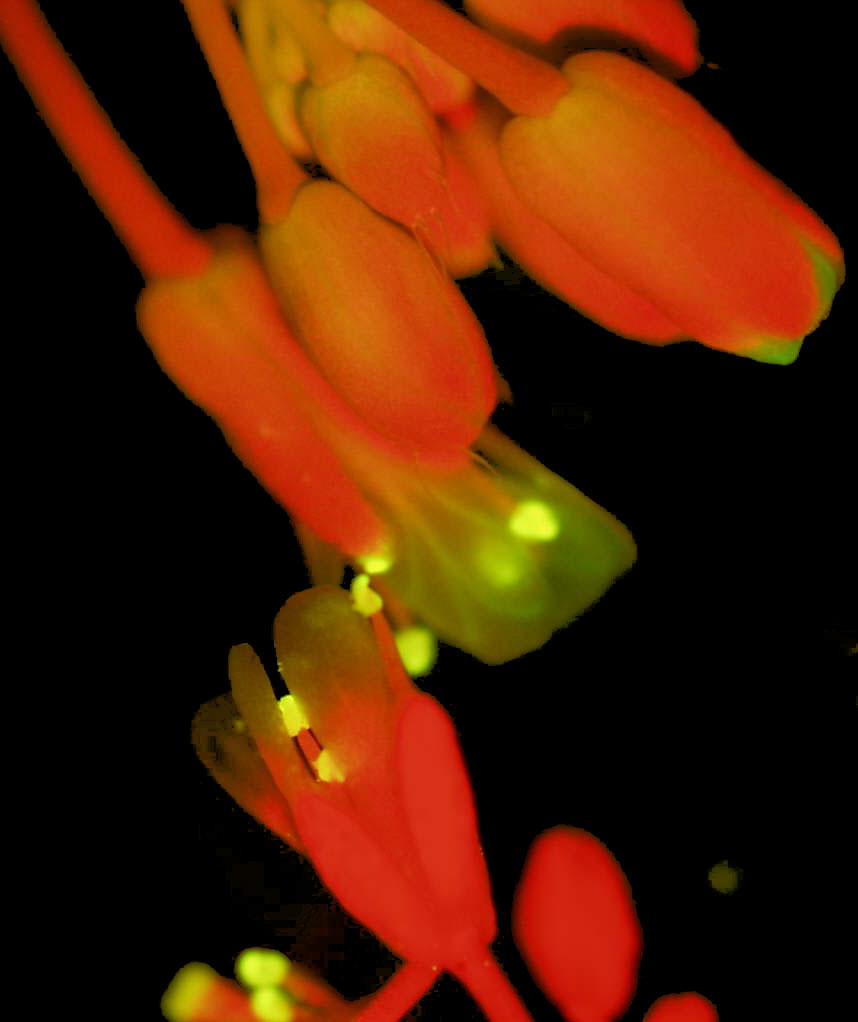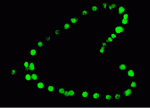GFP, YFP and RFP = Christmas Themes!
Posted by Linda, on 22 December 2010
The other beauty of Fluorescent Reporter Gene Systems is its undeniable likeness to holiday colours. So then, will we eventually see Christmas trees with genes hooked up to GFP, YFP and RFP?
![]()
The purposeful beauty of the system is in our ability to view artificial fluorescence (and hence the genes they report) throughout development in living tissue. There’s no need to freeze tissues in lethal chemicals to obtain results. Furthermore, we can observe fluorescence from teeny organelles under the confocal microscope to whole plants under a UV lamp. (Fantastic, now how do you switch it off?)
(Image: Ethereal looking Arabidopsis seed with glowing red nuclei, Development Cover Oct. 2009. Read more about it in the original article by Fitz Gerald et al., 2009)
Since the advent of RNAi, they’re now being used as molecular sensors for the occurrence of gene silencing in vivo. Recently, RNAi signal transport in tissues was uncovered using GFP. Researchers constructed a small RNA directed against the GFP sequences. What they found was quite surprising. If they injected their small RNAs in one leaf of a tobacco plant, which is widely expressing GFP, over time the GFP diminished first in the veins and then in tissues. Eventually, the fluorescence was quenched (summarized in Voinnet 2002).

Here in Australia, Peter Waterhouse (a Grand-daddy of RNAi in plants) is working on making live action movies of RNAi in progress. One new aim in his lab is to produce the “Zebrafish” of plants…a chlorophyll-less Arabidopsis plants. Weird or genius?
(Image: Tobacco plant afflicted with a virus can cause an unusual green glow similar to GFP. The red is autofluorescence from chlorophyll. Viral transport can overlap with the transport of RNAi signals, which also serves as a plant defense mechanism against viruses & other foreign nucleic acids. Flikr CC, by Xmort)
While beautiful, it’s a not perfect system in plants for a variety of reasons. The main one is autofluorescence, or the bright red grinch that inadvertently contrasts with the merry green. A microscope tech described it as nothing short of a total nightmare. Plants naturally fluoresce because of the pigments they contain ~ chlorophyll. The huge heap of noise it makes can block the signal from the reporter
 gene. However, it’s getting easier to get around this using a range of light filters. Some filters only allow a narrow wavelength of light to go through. Usually they’re specific to just the wavelength of the GFP/RFP/YFP signal, and this causes non-fluorescing tissue to appear black.
gene. However, it’s getting easier to get around this using a range of light filters. Some filters only allow a narrow wavelength of light to go through. Usually they’re specific to just the wavelength of the GFP/RFP/YFP signal, and this causes non-fluorescing tissue to appear black.
(Image: my own hideous encounter with autofluorescence :(, note that chlorophyll is absent in the pollen & petals).
At any rate, I won’t keep my fingers crossed for that fluorescent Christmas tree. But it could be potential electricity saver. Instead of purchasing a bunch of energy consuming twinkle lights, simply purchase a fluorescent bulb (doesn’t have to be UV) and switch it on in place of your regular house lights. And if you get tired of the fluorescence, spray or inject some RNAi on a branch.
On a side note, while looking for possible videos on reporter genes, I came across the following video on Youtube:
Growing Nerve Cells from Hair Follicle Stem Cells in Mice?
So…stem cells in hair follicles…highly related to nerve & brain stem cells? Exciting new trend..or weird?
Thanks for reading!
YFP in the Heart Stage embryo of Arabidopsis thaliana (Gifford 2003)
References:
Gerald, J., Hui, P., & Berger, F. (2009). Polycomb group-dependent imprinting of the actin regulator AtFH5 regulates morphogenesis in Arabidopsis thaliana Development, 136 (20), 3399-3404 DOI: 10.1242/dev.036921
Gifford, M. (2003). The Arabidopsis ACR4 gene plays a role in cell layer organisation during ovule integument and sepal margin development Development, 130 (18), 4249-4258 DOI: 10.1242/dev.00634



 (3 votes)
(3 votes)
I like the YFP heart! <3
The chlorophyll-less plant sounds intriguing too. I hadn't heard about that idea before. (Whereas I'd heard of hair follicle stem cells many times - and that's exactly why there need to be more plant posts on the Node! Learning new things...)
Good parallel between the chlorophyll-less plant, the hairless mouse, for visualizing fluorescent protein reporters. And people have been using chicken strains that don’t have pigment, to study normal pigment cell development, for decades, too.
Eva, me too :) Also, thanks for the Development Cover! It’s a perfect find, the seed looks really ornamental. By the way, feels great to be surrounded by other biology bloggers, I’m learning tonnes on The Node. There really should be more dialogue between biologists (outside of happy hours). Awesome that you want to hear more about plants! …And I think I’m love with WordPress. *sigh
Heather, pigmentless chickens sound interesting, I’m going to have to check that out. I didn’t know there were mutant chicken models.
The hairless mouse of the plant world does sound really exceptional. And it wouldn’t have any autofluorescence. But one downer to it is that chlorophyll is so essential to a plant. It’s what allows a plant to make its own food. While it’s possible for the plant to survive on sucrose, many genes and protein levels could be drastically affected. It may not grow very well either, and would be harder to maintain, as sucrose would also attract a lot of bacteria and fungi. It could be tricky in an experiment.